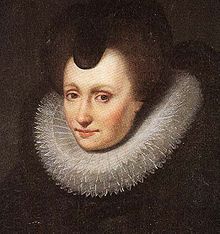Louise de Coligny
Louise de Coligny (born September 23, 1555 in Châtillon-sur-Loing , † November 13, 1620 in Fontainebleau ) was Princess of Orange-Nassau from 1583 by marrying William I of Orange-Nassau.
Life
childhood
Louise came as the eldest child of the French admiral Gaspard II. De Coligny and his wife Charlotte de Laval (1530–1568), daughter of Count Guy XVI. de Laval , to the world. She was raised humanist and, as the daughter of the French Huguenot leader, strictly Protestant . After the early death of her mother, she was placed in the care of Jeanne d'Albret , Queen of Navarre . Here she became a friend of the queen's son, later King Henry IV.
Countess of Téligny
When Louise was seventeen years old, on the advice of her father, she married Count Charles de Téligny (1535–1572), a favorite of the French King Charles IX, in 1571 . Both he and her father were murdered shortly afterwards on Bartholomew's Night on August 24, 1572, because they did not want to convert to Catholicism . Louise and her mother-in-law Jacqueline d'Entremonts first had to flee to Savoy and finally to Switzerland. Here she lived in Basel and Bern.
After the Edict of Beaulieu she was able to return to France in 1576 and lived on the estates of her late husband in Lierville. She appeared at court only once to reclaim her father's titles and property.
Princess of Orange-Nassau
Louise married Prince Wilhelm I of Orange-Nassau on April 21, 1583 in Antwerp as his fourth wife and in 1584 was the mother of Friedrich Heinrich , Wilhelm's fourth legitimate son and future Prince of Orange , who was to remain the only child of this marriage.
After her husband's murder in 1584, which she witnessed, she raised both her son and his third-married daughters and took care of their Protestant marriages. In order to establish contacts with French Huguenots , she and her stepdaughters Elisabeth Flandrika and Charlotte Brabantina traveled to Paris in 1594. She also took special care of the latter's daughter, her granddaughter Charlotte de La Trémoille , who later became Countess of Derby.
Because of her excellent connections with Protestant families and her continuing friendship with Henry IV, she played an important role in the political life of France and the Netherlands.
Louise lived in Delft until a year before her death . Then she went to the court of Maria de Medici at Fontainebleau Castle , where she also died.
She remained an advocate of Protestantism all her life. She is buried in the Nieuwe Kerk in Delft.
See also Coligny house
literature
- Roland H. Bainton : Louise de Coligny. In: Roland H. Bainton: Women of the Reformation in France and England. Beacon Press, Boston MA 1973, ISBN 0-8070-5649-9 .
- Jules Delaborde: Louise de Coligny. Princesse d'Orange. 2 volumes. Fischbacher, Paris 1890 (reprint. 2 volumes in 1 volume. Slatkine Reprints, Geneva 1970), online .
- Paul Marchegay, Léon Marlet: Correspondance de Louise de Coligny, princesse d'Orange (1555-1620) . Picard et al., Paris 1887, online .
- Pieter Lodewijk Muller : Luise de Colligny . In: Allgemeine Deutsche Biographie (ADB). Volume 19, Duncker & Humblot, Leipzig 1884, p. 625.
Web links
- Femke Deen: Louise de Coligny in Digitaal Vrouwenlexicon van Nederland (Dutch)
- Essay on Louise de Coligny by Jane Couchman ( Memento of April 5, 2008 in the Internet Archive ) (French)
| personal data | |
|---|---|
| SURNAME | Coligny, Louise de |
| BRIEF DESCRIPTION | by marriage to the Princess of Orange-Nassau |
| DATE OF BIRTH | September 23, 1555 |
| PLACE OF BIRTH | Châtillon-sur-Loing |
| DATE OF DEATH | November 13, 1620 |
| Place of death | Fontainebleau |

